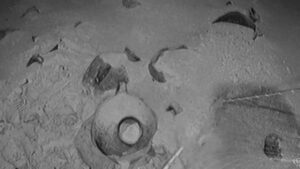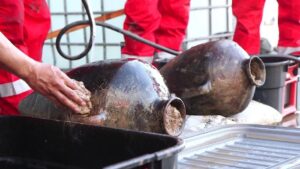
Imaging from the robotic underwater video shows jars protruding from the sea bed. Photo Israeli Antiquities Authority.
The discovery of the world’s oldest shipwreck, potentially from the late Bronze Age, was announced by the Israel Antiquities Authority in June. The merchant vessel, estimated to be 39 to 46 feet long, sank between 1400 B.C. and 1300 B.C. It was found about 56 miles off the northern coast of Israel in the Mediterranean Sea. This find is significant in part because shipwrecks from this period are extremely rare, with only two others known in the Mediterranean. The wreck is located farther from shore than studies of ancient seafaring would have suggested. Ancient sailors lacked navigational tools and boats hugged islands and coastal shores. Boats out of sight of land would have to rely on celestial navigation. This discovery promises to enhance our understanding of late Bronze Age trade patterns and maritime navigation.
The UK company Energean discovered the wreck at a depth of about a mile during a survey for natural gas fields. The site had been contested by Israel and Lebanon until a 2022 agreement placed it under Israeli control.
The ship seems to have settled on the seafloor without capsizing, having apparently sunk without breaking apart. It is remarkably intact after some three thousand years underwater. Unlike shipwrecks in more shallow waters, the wreck does not appear to have been damaged by currents. Its form can still be made out but there are no remaining signs of an anchor or mast. The film records shows that hundreds of storage jars in its hold remain largely intact.

Bronze Age vessels recovered from the sea bed. Photo Israeli Antiquities Authority.
The wreck is located at a depth below which any natural light can penetrate. A year ago, the company’s submersible robot filmed the site from some 3000 feet underwater and 2000 feet above where the ship rests, half-covered on the seabed. The remote operated vehicle filmed a pile of jugs of a type that the Israeli Antiquities Authority was able to identify as late Bronze Age storage jars, typically used for honey, olive oil, and a resin used as a preservative for wine and as a varnish.
Intrigued by the possibility of discovering details about patterns of ancient seafaring and trade during the Bronze Age, the gas company made modifications and added arms to the remote operated vehicle so that it would be capable of extracting objects from the wreck. The company returned to the site this May with a reconnaissance expedition by the Israeli Antiquities Authority. Two jars were carefully removed from the wreck to minimize any damage to it. Analysis is expected to determine their original contents.
Dr. Jacob Sharvit, the director of maritime archaeology for the Israel Antiquities Authority said that there are no plans to excavate the site. Instead, he said, it should be preserved intact until better technology is available to excavate at such extreme depths.
 Jacob Sharvit and Karnit Bahartan inspect the ancient jars, Photo Israeli Antiquities Authority.
Jacob Sharvit and Karnit Bahartan inspect the ancient jars, Photo Israeli Antiquities Authority. 

